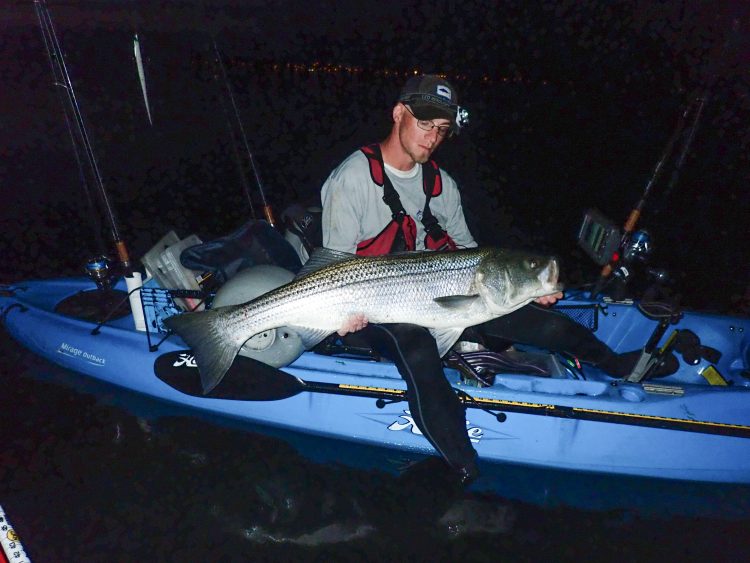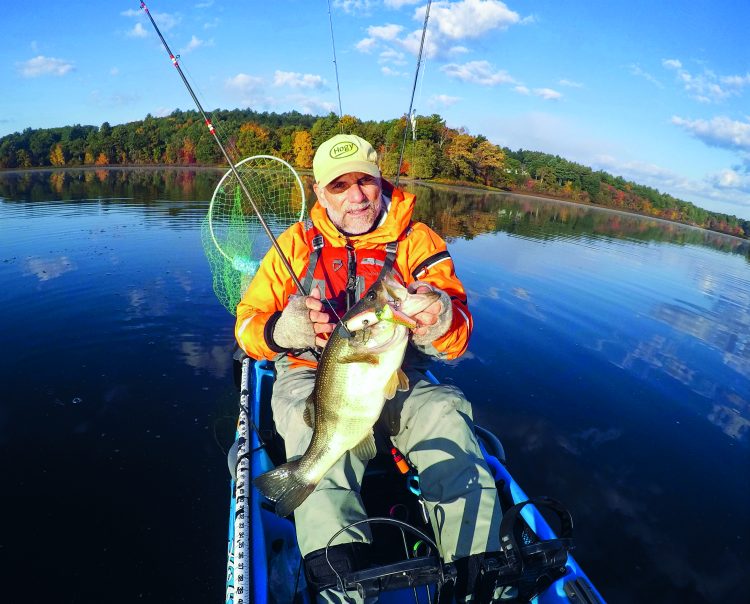Utilizing Stealth in Kayak Fishing
Kayak fishing for highly-pressured species like striped bass requires stealth, which, even at night, can be the difference-maker between catching fish and spooking them.
When people ask me why kayak fishing is such a successful technique, the first thing that comes to mind is stealth. Kayaks are about the quietest vessel on the water and that usually translates to catching more fish.
Over the last few years, I have become a big fan of side-scanning sonar. One important lesson it has taught me is that fish can be spooked even when actively feeding. They get turned off quickly by boats and commotion, and the side-scanning sonar shows how quickly they disappear when disturbed.

One of my favorite rips in the Boston area is very popular with boaters. On some nights, the spot is packed with boats and, usually, the more boats there are, the slower the striper action. I quickly learned that the stripers were still there, but they had changed their location in the rip. Instead of hanging in the middle of it with the boats, they drift further back in the rip or move to the sides. Boats trolling up and down the rip invariably moved the fish to its edges, so my solution was to drift the edges and fish structure that the boats couldn’t reach.
One of the advantages of side-scanning sonar is that I can see my impact on a school of stripers as I glide through them. More often than not, I see the fish moving away from the kayak; however, when the fish are touchy, even the kayak gets them moving off their spots, especially if I repeatedly troll through them. I have often noticed that there are many nights when I catch nothing on the troll, even when surrounded by fish. Stopping and casting is sometimes the only way to get the fish to eat. On calm nights, if I can see the fish pushing water or smell them, I get just close enough to drop a lure into the school. There are nights when only stealthy approaches work—when stripers get shy, there’s no approaching them. Knowledgeable boaters shut off their engines and drift in the areas where bass are schooling, but in kayaks, we can slowly shadow the fish by quietly pedaling along with them.
Striped bass aren’t the only fish that are boat-shy – carp are a notoriously spooky fish. They often stage in an area, then exit if disturbed, so a kayak allows me to approach them, especially in deeper water. I have a couple spots where I drift baits for them in 10 feet of water, and they do tend to spook after I catch a few.
Even largemouth bass can be boat-shy. In heavy cover, they are very confident fish, and it sometimes takes quite a bit to scare them away, but in the fall, when that cover dies, they become much more mobile. One of my favorite fall techniques is to fish flats and dead weedbeds using a slow wind drift. There’s one flat that I regularly fish every fall, and if I troll over it, I usually catch one fish, but if I do a slow drift, I can stay with the fish for hours. Trolling over the flats usually spooks the schools of bait the bass are shadowing, but if I watch the bait on my side scan, I can stay off of the bait and the bass won’t move away.

The other part of the stealth experience in a kayak is that fish will follow your lures up to the boat without turning off. When fishing largemouths, I always swim my favorite plug all the way to my rod tip. In fresh water, kayaks can get into places that can’t be accessed by power boats or waders because the shallow draft of a kayak can put us in spots seldom fished. Crappies in cover are probably the easiest fish to access. Instead of spooking, they move deeper into the cover. I’ve hitched my kayak to fallen trees and had lights-out crappie fishing all around the boat.
A drifting kayak makes very little commotion and is a good way to find stripers and albies chasing bait. We have all watched boaters rush into schools of breaking fish with engines blasting, and if they’re lucky, they may get a few casts off before the fish disappear. More experienced boaters remain a cast away and allow the fish to keep feeding on top. Experienced kayakers watch where the bait balls are and drift through them – eventually the predators come through and tear up the bait. There’s nothing quite like sitting in the middle of breaking fish in a kayak. I’ve even had baitfish coming through the scupper holes and drive well to get away!
Related Content
1 thought on “Utilizing Stealth in Kayak Fishing”
-
Yakanglr Another great read. Nice fish Danny and Eric.
Leave a Reply